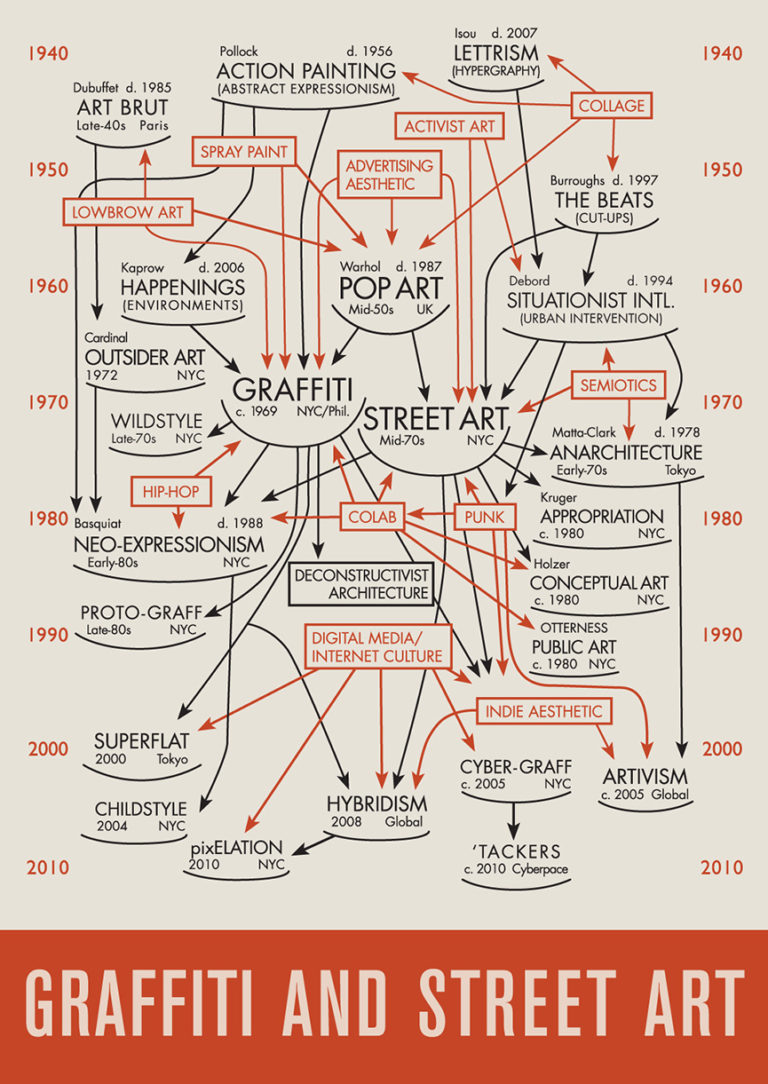Street Art and Locations and Purpose and Date Street Art and Locations
Any type of history is a soapbox in its ain right. What is more, when talking most art history, the discourses seem to flourish immensely from 1 into some other, and and then on into many more. In the context of the beginnings, one cannot but firstly reflect upon the artwork of graffiti. Subsequently, by the cease of the 20th century and the commencement of the 21st, street art has evolved into complex interdisciplinary forms of creative expression. From graffiti, stencils, prints and murals, through large-scale paintings and projects of artistic collaboration, to street installations, as well every bit performative and video fine art, it is very much safe to say that street art has found it's fashion into the core of contemporary art. And rightly so.

Where Did it Come From?
Some of the primeval expressions of street fine art were certainly the graffiti which started showing up on the sides of railroad train cars and walls. This was the work of gangs in the 1920s and 1930s New York. The impact of this subversive culture was extraordinarily felt in the 1970s and 1980s. This cultural movement was recorded in the volume The History of American Graffiti, by Roger Gastman and Caleb Neelon. These decades were a significant turning point in the history of street art – information technology was a time when young people, by responding to their socio-political environment, started creating a move, taking the 'battle for meaning' into their ain hands.
Shortly, this subcultural phenomenon gained the attention and respect in the 'grown-up' world. From the fingers and cans of teenagers, information technology had taken a form of true creative expression. One of the most respected names in the field of documenting street art and artists, who would gladly testify to this, is photographer Martha Cooper. Shortly enough, photographs weren't the only medium for capturing and 'displacing' street art into different contexts. Essentially an illegal activity, a process of creation through destruction began its evolution into numerous forms of creative expression which constitute information technology'due south way to galleries and the global fine art market. Although notwithstanding subversive, and in its large part an illegal motion, through art enthusiasts and professionals, street art earned its place in the contemporary fine art earth.

What almost Street Art Today?
This is non a story simply about graffiti. Although street fine art owes a part of its celebrity to this kind of creative expression, information technology is a marvelous art class in its ain correct and information technology is amazing to follow the evolution and diversity of street art in the 21stst century. For instance, stencils take been a office of history parallel to graffiti and accept been vessels for socio-political activism for those in ability, and even more for those who resisted. The evolution of street art became axiomatic through such artists as Banksy, who transformed views of this art form with his documentary Exit through the gift store. With the emergence of artists such Vhils or BLU, street fine art became a ground for experimenting with different kinds of methodology, just never giving up on its rebellious position in forepart of the hegemonistic patterns and structures of popular culture and mass media reality.
Thus, street fine art gave nascence to artists who create breathtaking murals, and those who have incorporated video art and other performative aspects to artistic piece of work 'on the streets'. To understand the history of street art, ane must immerse oneself into the free energy of this sublime cultural phenomenon, as an admirer, but perhaps as a creator every bit well.

Editors' Tip: The World Atlas of Street Art and Graffiti Hardcover by Rafael Schacter
From painted murals in Latin America in the early on 20th century through Latino gangs spray-can graffiti in the 1950s, street art has traveled a long way to go what it is today. Omnipresent globally, it has evolved into a complex fine art form encompassing various practices. The Earth Atlas of Street Art and Graffiti is a survey of international art scene and brings together the globe's nearly influential urban artists and their piece of work. This illustrated book as well features specially commissioned "city artworks", also as the evolution of street art and graffiti within each region. Organized geographically, the book presents the work of more than hundred important street artists such as Espo in New York, Shepard Fairey in Los Angeles, Os Gêmeos in Brazil, or Anthony Lister in Australia.
The Influences of Street Fine art

0 Response to "Street Art and Locations and Purpose and Date Street Art and Locations"
Enregistrer un commentaire